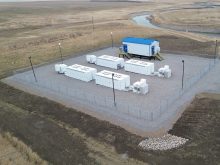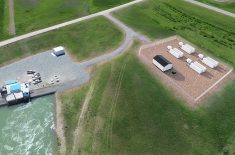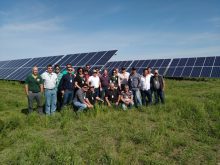Municipalities told they can expect more than $100 million in tax revenue over the 35-year life of these energy projects
It’s been more than five years since the Green Acres Hutterite Colony near Bassano, Alta., powered up what was then the largest solar project in the country with its two-megawatt installation.
Now, Vulcan County’s Travers Solar Project is set to trump Green Acres in power production with a 465-megawatt project set to start up next year.
It marks a huge jump in just a few years with similar projects underway.
Earlier this summer, Cypress County council members were presented with two solar projects: one 465 megawatts and the other 300 megawatts.
Read Also

Agri-business and farms front and centre for Alberta’s Open Farm Days
Open Farm Days continues to enjoy success in its 14th year running, as Alberta farms and agri-businesses were showcased to increase awareness on how food gets to the dinner plate.
“One of the most important things here for the county itself is the significant tax revenue,” Dan Tocher, Greengate vice-president, told county councillors during the presentation of the Midnight and Jurassic proposals.
“We’re looking at an excess of $100 million over the life of the project to the county.”
That amount would be spread over 35 years to the rural municipality, which garners $25 million annually from property taxes.
It also comes on top of construction jobs and a community fund Greengate would establish like it did with the Travers project, which the company also built.
However, there are concerns about such projects with Cypress councillors focusing on fire risks and the ability of rural volunteer departments to fight a blaze rolling through an electric-generation power station. Weed control to protect neighbouring pastures from invasive plants is also a concern.
Tocher told councillors that methods to lower those risks are still being developed but they would include fire breaks and sheep grazing as a way to mitigate negative effects across the 6,000-acre combined footprint of the two projects.
Evan Wilson, senior director at national advocacy group Canadian Renewable Energy Association, said Alberta’s rural residents have a history of dealing with energy project issues.
“The renewable energy industry has been active in Alberta going back almost 25 years,” said Wilson, highlighting the first wind projects developed in the province in the mid-1990s.
“The land base in Alberta is very knowledgeable but at the same time very open to partnerships where it is appropriate and open to hosting projects on their land.”
Unlike oil and gas infrastructure, which can be forced on Alberta landowners, Wilson said renewables are voluntary.
“What we’ve seen here in Alberta is really productive relationships because the rules put the landowners in the driver’s seat,” said Wilson.
That includes negotiations at the beginning of projects for everything from compensation to remediation.
New regulatory rules in Alberta will also strengthen the reclamation process, said Wilson.
Those will “require a demonstration of what a reclamation commitment looks like and to demonstrate they have funds that are being set aside to deal with reclamation.”
As for renewable projects removing productive agricultural land, Wilson said with wind projects, footprints are relatively small with the ability to farm or graze up to the base of turbines.
Solar projects are more complicated because they take up a continuous swath of land.
Wilson said those issues can be tackled through consultations with landowners to establish targets that maintain biodiversity and habitat.
Renewable energy projects can provide a stable revenue source in agricultural areas where incomes often fluctuate, providing about $500,000 in taxes per 100 megawatts annually to rural municipalities in Alberta.
















